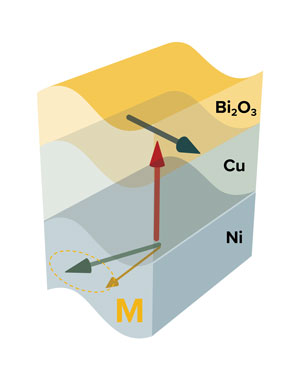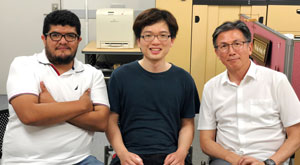Jul. 20, 2018 Research Highlight Physics / Astronomy
Using spin current to convert mechanical vibrations into electricity
A nanodevice that generates an electrical current from a spin current, which in turn is generated by mechanical oscillations, demonstrates the versatility of electron spin to convert between energy forms
 Figure 1: Surface waves in the substrate (not shown) cause the magnetization (orange arrow) in the bottom nickel layer to precess, which generates a spin current (red arrow) in the second copper layer. This is converted into an electric current (dark grey arrow) in the top bismuth oxide layer. Reprinted with permission from Ref. 1. Copyright (2018) by the American Physical Society.
Figure 1: Surface waves in the substrate (not shown) cause the magnetization (orange arrow) in the bottom nickel layer to precess, which generates a spin current (red arrow) in the second copper layer. This is converted into an electric current (dark grey arrow) in the top bismuth oxide layer. Reprinted with permission from Ref. 1. Copyright (2018) by the American Physical Society.
A nanoscale device that converts mechanical ripples into an electrical current via a ‘spin current’ has been made by RIKEN researchers1. Further development of this technology could see it used in devices that permit sound waves to pass in one direction but block them in the opposite direction.
Conventional electronic devices are based on shunting electrons around circuits. Because electrons possess charge, they give rise to electric currents when they move. The emerging field of spintronics, however, harnesses another property of electrons: their spin. Spin currents are the spintronic equivalent of electric currents, but unlike electric currents, they can flow without the electrons actually moving since spin can be transferred between stationary electrons.
As well as holding out the promise of resistance-free energy flow, electron spin can be used to convert between various forms of energy, including electricity, light, sound, vibrations and heat. This ability to switch between different energy forms will lead to a wide range of versatile devices.
Jorge Puebla at the RIKEN Center for Emergent Matter Science and Mingran Xu at the University of Tokyo and colleagues have made a three-layered nanodevice that converts mechanical vibrations into electric current. Waves generated on the surface of a substrate cause the magnetization of the bottom nickel layer of the device to sweep out arcs (Fig. 1). This periodic motion of the magnetization generates a spin current in the second copper layer. Finally, the spin current is converted into an electric current at the interface with the top bismuth oxide layer.
 (From left to right) Jorge Puebla, Mingran Xu and Yoshichika Otani of the Quantum Nano-Scale Magnetism Research Team at RIKEN have created a hybrid nanodevice that creates a spin current from acoustic spin waves using the inverse Edelstein effect and then converts it into an electric current. © 2018 RIKEN
(From left to right) Jorge Puebla, Mingran Xu and Yoshichika Otani of the Quantum Nano-Scale Magnetism Research Team at RIKEN have created a hybrid nanodevice that creates a spin current from acoustic spin waves using the inverse Edelstein effect and then converts it into an electric current. © 2018 RIKEN
The team found that the spin current generated in the second layer was particularly large. “In our field, researchers are seeking to generate higher spin currents,” explains Xu. “Our method produces quite a huge spin current.”
“We’re approaching spin currents that are large enough to move magnetic domain walls, which could be used in memory devices,” adds Puebla. “We’re still below the spin currents needed, but believe we should be able to get close by optimizing our devices.”
Another advance was the use of a relatively new way to convert a spin current into an electrical one. Often expensive metals such as platinum are required for this conversion, but the method the team used worked with copper. “I think in terms of technology, people might find this approach cheaper to produce real devices,” comments Xu.
Since the output varied with direction, a potential application is audio devices that allow sound to flow in one direction but not the opposite one. “You could have headphones that allow you to listen to music and hear what others are saying, but other people cannot hear what you’re listening to,” says Puebla.
Related contents
- Spins line up for data duty
- Metal−oxide interfaces create a flipping point
- Moving forward, spin goes sideways
References
- 1. Xu, M., Puebla, J., Auvray, F., Rana, B., Kondou, K. & Otani, Y. Inverse Edelstein effect induced by magnon-phonon coupling. Physical Review B 97, 180301 (2018). doi: 10.1103/PhysRevB.97.180301
